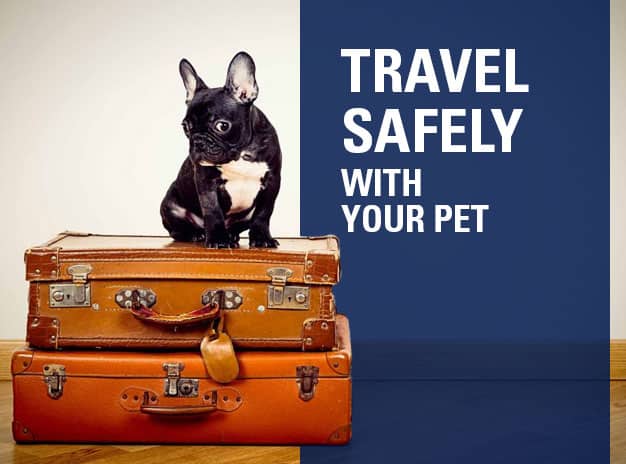Bringing your favorite pet can add to the fun of a vacation, but only if you plan ahead carefully. Here are some tips for a safe & low-stress trip:
- Your dog or cat should have identification tag on its collar, as well as identification on your pet’s crate. Be sure to include the pet’s name, your name and your current contact information
- Make sure the microchip registration is up to date. If your dog or cat is not microchipped, consider this option well ahead of time
- Pack a travel kit for your dog or cat: include food, bowl, collar & leash, plastic bags, water and your pet’s toy/pillow/blanket
When traveling by car
Traveling by car is the easiest and most common way for traveling with your pet.
• The ASPCA (American Society for the Prevention of Cruelty to Animals) recommends securing dogs & cats in crates or carriers, for everyone’s safety
• Crates should be secured in the back seat and strapped in, so that the crate won’t slide around
• Choose the right size crate according to your pet’s size. It should be large enough for your dog/cat stand up, turn around and lie down comfortably, and it should have proper ventilation
• If a crate is not an option, keep your pet in the back seat in a harness attached to a seat buckle
• Don’t allow your pet to ride with his head outside the window
• Never leave your pet alone in a parked vehicle
When traveling by air
Air Travel can be risky for pets; before you make this decision consider all the alternatives to flying. If you do decide to fly with your pet, research airline policies and make sure to understand the risks and restrictions.
• Book a direct flight and choose cabin when possible.
• Make an appointment with your pet’s vet for a full check up prior to your trip, and request a Certificate of Veterinary Inspection (Issued within 10 days of travel)
*Pets traveling in the cargo area of a plane are exposed to higher risks. If flying is your only option, it might be a better idea to leave your pet at a boarding facility or under the care of a friend or sitter for your pet’s safety and comfort.
According to the U.S. Department of Transportation, short-nose dogs and cats, brachycephalic breeds, (i.e. Persian, Himalayan and Burmese in cats and dogs such as Pugs or Shih Tzus) are more vulnerable to chronic respiratory issues, such as oxygen deprivation and heat stroke at high altitudes than their counterparts. For these reason many airlines have banned brachycephalic breeds, either seasonally or altogether.
Prepare for the day of the flight
- Do not feed your pet four to six hours before the flight; however, make sure he is well hydrated
- Arrive early so you have time to exercise your pet and offer a bathroom break
- Once you arrive at your destination, provide fresh water for your pet and go for a long walk
Despite the risks involved, thousands of dogs and cats travel by plane every year. Regardless of your travel plans, do your homework to ensure safe and enjoyable trip for everyone, and discuss all the risks with your pet’s vet before making decisions.
If you would like to review insurance policies for pets, please contact Rachel Good at (412) 754-3165 or email me at [email protected].

Please note that the information contained in this posting is designed to provide authoritative and accurate information, in regard to the subject matter covered. However, it is not provided as legal or tax advice and no representation is made as to the sufficiency for your specific company’s needs. This post should be reviewed by your legal counsel or tax consultant before use.

